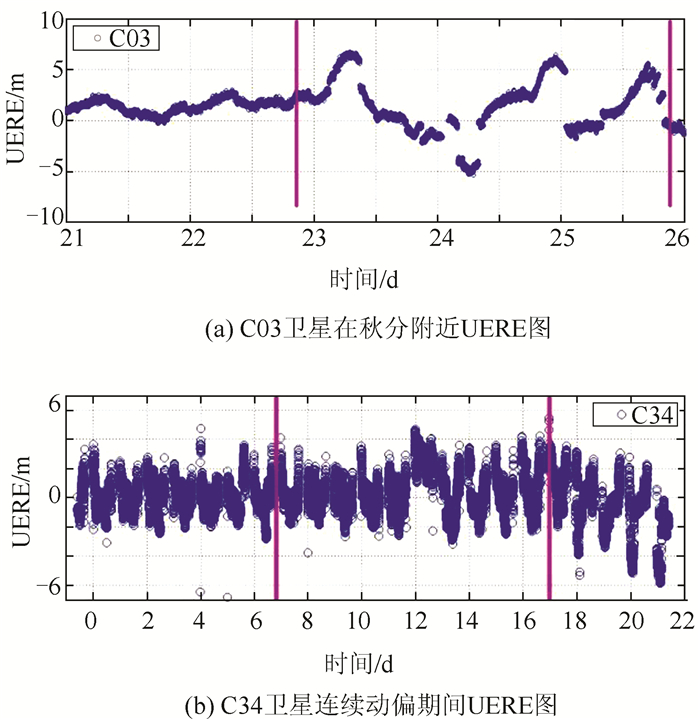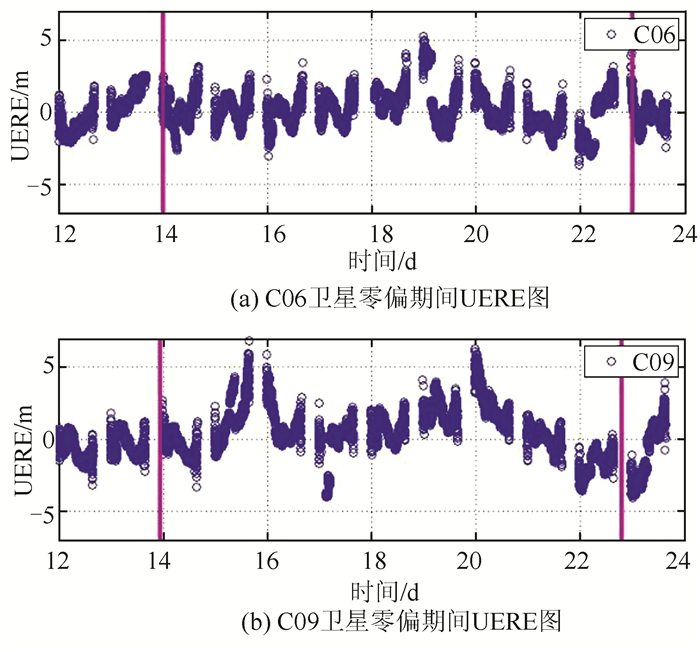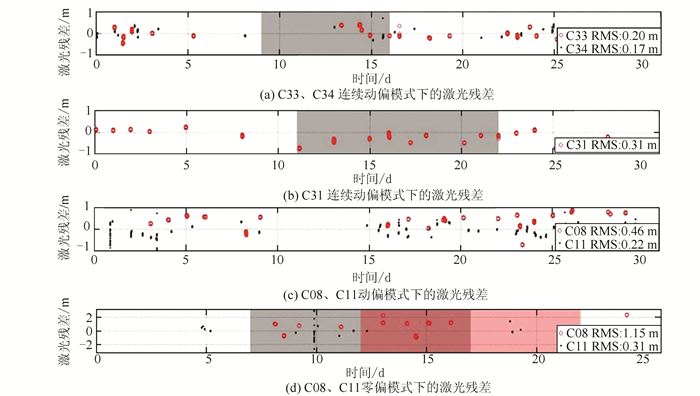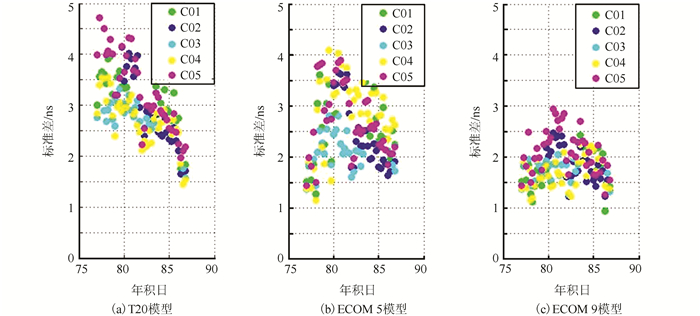Orbit Determining Strategy Analysis for BeiDou Satellite in Different Attitude Control Modes
-
摘要: 北斗卫星的姿态控制分为动态偏置、零偏置和连续动偏3种,不同类型卫星、不同姿态控制模式、不同时段下定轨精度不一致,影响了北斗系统的连续性。详细研究了北斗不同类型卫星在不同姿态控制模式下的最优定轨策略,并基于实测数据进行试验,结果表明,BeiDou-2 IGSO(inclined geosynchronous orbit)/MEO(medium earth orbit)卫星采用基于星地钟差约束下多星定轨方法和ECOM(extended CODE model)5参数模型相结合的方法定轨精度最优,零偏期间,用户等效距离误差值为2.08 m,全球激光评估轨道视向精度约为1 m;BeiDou-3 IGSO/MEO卫星采用常规多星定轨和ECOM 5参数模型相结合的方法定轨精度最优;连续动偏期间,用户等效距离误差值为1.22 m,全球激光评估轨道视向精度为0.23 m,与动偏期间精度一致;GEO(geostationary earth orbit)卫星在春秋分附近时段采用基于星地钟差约束下多星定轨方法和ECOM 9参数模型相结合的方法定轨精度最优,用户等效距离误差值为0.72 m。Abstract: The BeiDou navigation satellite system have three attitude control modes-yaw-steering(YS) mode, orbit-normal(ON) mode and continuous yaw-steering(CYS) mode. The orbit accuracy and best orbit determination projects for different satellites were a hot topic at present in different time and different attitude control mode, which are researched and whose the dynamical mechanisms is analyzed in this paper. The results are as follows. For BeiDou-2 satellites, multi-satellite precise orbit determination by fixing satellite/station clock offset and extended CODE model (ECOM) 5 SRP should be the best project, user equivalent range errors (UERE) root mean square (RMS) in ON mode is 2.08 m, global satellite laser ranging (SLR) data fitting RMS is ablout 1 m. For BeiDou-3 satellites, multi-satellite precise orbit determination and ECOM 5 SRP should be the best project, UERE RMS in CYS mode is 1.22 m, SLR data fitting RMS is 0.23 m, which is comparable to that in YS mode. For GEO satellites near spring or autumn equinox, multi-satellite precise orbit determination by fixing satellite/station clock offset and ECOM 9 SRP should be the best project, UERE RMS is 0.72 m.
-
-
表 1 动偏、零偏、连续动偏IGSO/MEO卫星受照状态比较
Table 1 Solar Irradiation on IGSO/MEO Satellites in Different Attitude Modes
工作方式 偏航姿态 星体面板 太阳帆板 动偏 偏航角随太阳位置连续变化 对地面板(+Z轴)、背地面板(-Z轴)轮流受照,东面板(+X轴)始终受照,南北面板(+Y和-Y轴)不受照 太阳光线垂直入射 零偏 偏航角恒为0° 对地面板(+Z轴)、背地面板(-Z轴)轮流受照, 东西面板(+X和-X轴)轮流受照, 南面板(+Y轴)或北面板(-Y轴)部分受照 太阳光线与太阳帆板法向夹角不超过5° 连续动偏 正常时段偏航角随太阳位置连续变化,正午和子夜附近采用偏航机动 对地面板(+Z轴)、背地面板(-Z轴)轮流受照,东面板(+X轴)始终受照,南面板(+Y轴)或北面板(-Y轴)部分受照,西面板(-X轴)不受照 太阳光线与太阳帆板法向夹角不超过5° 表 2 GEO卫星在非地影期和地影期星体面板受照状态比较
Table 2 Solar Irradiation on GEO's Body in and not in Earth Eclipsing Period
+X和-X面板受照情况 +Y和-Y面板受照情况 +Z和-Z面板受照情况 非地影期 +X面与-X面受太阳照射的时间相等,为轨道周期(设为T)的一半 整个轨道周期内Y面板均受照,β>0°时,-Y面受照,β < 0°,+Y面受照 +Z面与-Z面受太阳照射的时间相等,为轨道周期(设为T)的一半 地影期(春秋分附近时段) +X和-X面受照时间依然相等,但受照时间均小于T/2 Y面板在轨道周期内并非全弧段受照,卫星进地影后,+Y和-Y面板均不受照 +Z和-Z面受照时间依然相等,但受照时间均小于T/2 表 3 连续动偏期间基于不同光压模型的UERE精度比较/m
Table 3 UERE by Different Solar Radiation Pressure Models in Continuous Yaw-Steering Mode/m
卫星 ECOM 9 ECOM 5 T20 C31 1.85 1.28 1.36 C33 1.79 1.23 1.30 C34 1.60 1.15 1.21 平均 1.75 1.22 1.29 表 4 北斗GEO卫星基于不同定轨模式的UERE精度比较/m
Table 4 UERE by Different POD Projects for GEO Satellite/m
卫星 模式1 模式2 模式3 C01 1.86 0.51 0.47 C02 2.10 0.77 0.72 C03 2.54 0.82 0.75 C04 2.31 0.75 0.73 C05 1.85 1.28 0.95 平均 2.13 0.83 0.72 -
[1] 李晓杰, 黄勇, 郭睿, 等.基于机动力模型的GEO卫星恢复期间定轨[J].空间科学学报, 2015, 35(6):405-411 http://d.old.wanfangdata.com.cn/Periodical/kjkxxb201506010 Li Xiaojie, Huang Yong, Guo Rui, et al. An Orbit Determination Method Based on Thrust Force Model During Satellite Orbit Recovery[J]. Chinese Journal of Space Science, 2015, 35(6):405-411 http://d.old.wanfangdata.com.cn/Periodical/kjkxxb201506010
[2] 周善石.基于区域监测网的卫星导航系统精密定轨方法研究[D].上海: 中国科学院上海天文台, 2011 http://d.wanfangdata.com.cn/Thesis/Y2035391 Zhou Shanshi. Studies on Precise Orbit Determination Theory and Application for Satellite Navigation System with Regional Tracking Network[D]. Shanghai: Shanghai Astronomical Observatory, Chinese Academy of Sciences, 2011 http://d.wanfangdata.com.cn/Thesis/Y2035391
[3] Li Xiaojie, Zhou Jianhua, Guo Rui. High-Precision Orbit Predication and Error Control Techniques for COMPASS Navigation Satellite[J]. Chinese Science Bulletin, 2014, 59(23):2841-2849 doi: 10.1007/s11434-014-0346-y
[4] Li Xiaojie, Zhou Jianhua, Hu Xiaogong, et al. Orbit Determination and Prediction for BeiDou GEO Satellites at the Time of the Spring/Autumn Equinox[J]. Scinece China:Physics, Mechanics & Astronomy, 2015, 58(8):089501 http://www.wanfangdata.com.cn/details/detail.do?_type=perio&id=zgkx-eg201508009
[5] 郭靖.姿态、光压和函数模型对导航卫星精密定轨影响的研究[D].武汉: 武汉大学, 2014 http://cdmd.cnki.com.cn/Article/CDMD-10486-1015528772.htm Guo Jing. The Impacts of Attitude, Solar Radiation and Function Model on Precise Orbit Determination for GNSS Satellites[D]. Wuhan: Wuhan University, 2014 http://cdmd.cnki.com.cn/Article/CDMD-10486-1015528772.htm
[6] 毛悦, 宋小勇, 王维, 等. IGSO姿态控制模式切换期间定轨策略研究[J].武汉大学学报·信息科学版, 2014, 39(11):1352-1356 http://ch.whu.edu.cn/CN/abstract/abstract3123.shtml Mao Yue, Song Xiaoyong, Wang Wei, et al. IGSO Satellite Orbit Determining Strategy Analysis with the Yaw-Steering and Orbit-Normal Attitude Control Mode Switching[J]. Geomatics and Information Science of Wuhan University, 2014, 39(11):1352-1356 http://ch.whu.edu.cn/CN/abstract/abstract3123.shtml
[7] Feng Weidong, Guo Xiangyu, Qiu Hongxing. A Study of Analytical Solar Radiation Pressure Modeling for BeiDou Navigation Satellites Based on Ray Tracing Method[C]. China Satellite Navigation Conference (CSNC), Nanjing, China, 2014
[8] Tang C P, Hu X G, Zhou S S, et al. Improvement of Orbit Determination Accuracy for BeiDou Navigation Satellite System with Two-Way Satellite Time Frequency Transfer[J]. Advance Space Research, 2016, 58(7):1390-1400 doi: 10.1016/j.asr.2016.06.007
[9] Guo J, Xu X L, Zhao Q L, et al. Precise Orbit Determination for Quad-constellation Satellites at Wuhan University:Strategy, Result Validation, and Comparison[J]. Journal of Geodesy, 2016, 90:143-159 doi: 10.1007/s00190-015-0862-9
[10] Ji G F, Liu Y X, Yang Z Q, et al. A Study on the Orbit Accuracy Variation Characteristics and Yaw-Attitude Modes of BeiDou Navigation Satellites[C]. China Satellite Navigation Conference (CSNC), Shanghai, China, 2017
[11] Zhou S S, Hu X G, Wu B. Orbit Determination and Prediction Accuracy Analysis for a Regional Tracking Network[J]. Science China:Physics, Mechanics & Astronomy, 2010, 53:1130-1138
[12] Zhou S S, Hu X G, Wu B. Orbit Determination and Time Synchronization for a GEO/IGSO Satellite Navigation Constellation with Regional Tracking Network[J]. Science China:Physics, Mechanics & Astronomy, 2011, 54(6):1089-1097 http://www.wanfangdata.com.cn/details/detail.do?_type=perio&id=zgkx-eg201106015
[13] Guo R, Hu X G, Tang B, et al. Precise Orbit Determination for Geostationary Satellites with Multiple Tracking Techniques[J]. Chinese Science Bulletin, 2010, 55(8):687-692 doi: 10.1007/s11434-010-0074-x
[14] Fliegel H F, Gallini T E. Solar Force Modeling of Block ⅡR Global Positioning System Satellites[J]. Journal of Spacecraft and Rockets, 1996, 33(6):863-866 doi: 10.2514/3.26851
[15] 毛悦, 宋小勇, 王维, 等.北斗IGSO/MEO卫星姿态控制及光压差异分析[J].测绘科学, 2015, 40(8):129-134 http://www.wanfangdata.com.cn/details/detail.do?_type=perio&id=chkx201508028 Mao Yue, Song Xiaoyong, Wang Wei, et al. BeiDou IGSO and MEO Navigation Satellites' Yaw-Steering and Orbit-Normal Attitude Control Modes and Solar Radiation Pressure Difference Analysis[J]. Science of Surveying and Mapping, 2015, 40(8):129-134 http://www.wanfangdata.com.cn/details/detail.do?_type=perio&id=chkx201508028
[16] 毛悦, 宋小勇, 贾小林, 等.北斗导航卫星地影状态分析[J].测绘学报, 2014, 43(4):353-359 http://www.wanfangdata.com.cn/details/detail.do?_type=perio&id=chxb201404006 Mao Yue, Song Xiaoyong, Jia Xiaolin, et al. Earth Eclipse Status Analysis of BeiDou Navigation Satellites[J]. Acta Geodaetica et Cartographica Sinica, 2014, 43(4):353-359 http://www.wanfangdata.com.cn/details/detail.do?_type=perio&id=chxb201404006
[17] Montenbruck O, Steigenberger P, Kirchner G. GNSS Satellite Orbit Validation Using Satellite Laser Ranging[R]. 18th ILRS Workshop on Laser Ranging, Fujiyoshida, Japan, 2013
[18] Zhao G, Zhou S S, Zhou X H, et al. Orbit Accuracy Analysis for BeiDou Regional Tracing Network[C]. China Satellite Navigation Conference, Changsha, China, 2016
-
期刊类型引用(11)
1. 赵涛,叶世榕,罗歆琪,夏朋飞. GNSS-IR潮位反演中高仰角数据质量控制方法. 武汉大学学报(信息科学版). 2024(01): 68-76 .  百度学术
百度学术
2. 肖倩雨,周春霞,刘勇. 利用改进的亮温日较差法探测格陵兰冰盖表面融化. 武汉大学学报(信息科学版). 2024(10): 1931-1939 .  百度学术
百度学术
3. 李荣兴,何美茜,葛绍仓,程远,安璐. 东南极历史冰流速过估改正. 武汉大学学报(信息科学版). 2023(10): 1661-1669 .  百度学术
百度学术
4. 张冕,张春灌,赵敏,钟振华,袁炳强,周磊,韩梅. 地球磁异常EMAG2v3与全球重力数据库V29数据质量综合评估——以北极地区Aegir脊为例. 物探与化探. 2023(06): 1410-1416 .  百度学术
百度学术
5. 张金辉,李姗姗,杨光,范雕,凌晴. 联合CTD、海底地形和ARGO数据构建北太平洋深海时变温度模型. 测绘通报. 2023(12): 94-101+126 .  百度学术
百度学术
6. 徐天河,穆大鹏,闫昊明,郭金运,尹鹏. 近20年海平面变化成因研究进展及挑战. 测绘学报. 2022(07): 1294-1305 .  百度学术
百度学术
7. 徐天河,杨元元,穆大鹏,尹鹏. 近海海平面变化成因分析. 武汉大学学报(信息科学版). 2022(10): 1750-1757 .  百度学术
百度学术
8. 陈旭升,张云龙,张冠军. 优化局部均值分解在趋势信息提取中的应用. 测绘科学. 2022(11): 32-39 .  百度学术
百度学术
9. 房婷婷,付广裕. 卫星重力与地球重力场的文献计量分析. 地球科学进展. 2021(05): 543-552 .  百度学术
百度学术
10. 冯哲颖,岳林蔚,沈焕锋. 基于多源水文数据融合的GRACE水储量精度校正. 遥感技术与应用. 2021(03): 605-617 .  百度学术
百度学术
11. 刘冰石,邹贤才. ENSO影响下的西太平洋地区海陆水储量变化分析. 武汉大学学报(信息科学版). 2019(09): 1296-1303 .  百度学术
百度学术
其他类型引用(11)





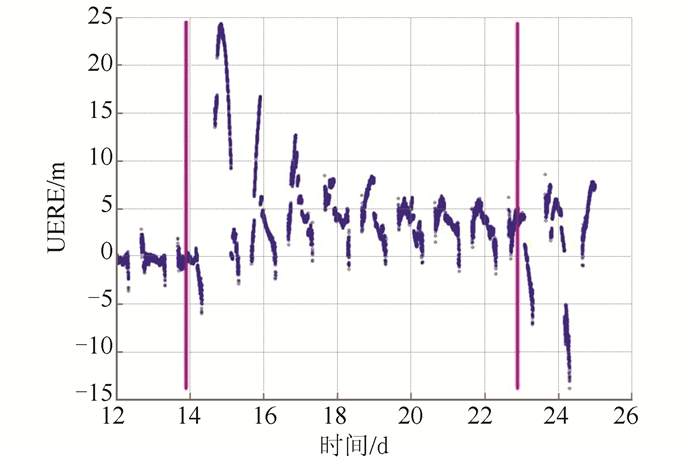
 下载:
下载:
